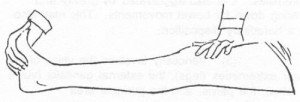a. Backache.
(1) Backache is caused by relaxation of the sacroiliac joint which is due to increased hormones (steroid sex hormone and relaxing) resulting in slight joint and muscle relaxation and increased mobility; and exaggerated lumbar and cervico thoracic curves caused by changes in the center of gravity from the enlarging abdomen and breasts.
(2) Prevention of strain, which can cause backache, should begin early in pregnancy.
(3) Nursing interventions consist of advising the patient:
(a) That maternity girdles are no longer recommended.
(b) To practice good posture and good body mechanics (use the pelvic tilt and bend at the knees).
(c) To wear appropriate, well-fitting shoes.
(d) To sleep on a firm mattress or backboard.
(e) That backaches may indicate a kidney or bladder infection. The patient must inform the physician of backache problems. Backaches should be carefully evaluated.
b. Muscle Cramps.
(1) Muscle cramps are caused by:
(a) Compression of nerves supplying the lower extremities due to the enlarging uterus.
(b) Reduced level of diffusible serum calcium or elevation of serum phosphorus in the bloodstream.
(c) Fatigue, chilling, or tense body posture.
(2) Muscle cramps are not considered a serious condition, but they may be quite painful.

(3) Nursing interventions consists of advising the patient to:
(a) Avoid fatigue and cold legs.
(b) Eat a diet with adequate calcium or prescribed calcium.
(c) Avoid drinking more than one (1) quart of milk per day. More than one quart of milk per day will create too much phosphorus in the system.
(d) Take the prescribed vitamins B and D per doctor’s instructions.
(4) Treatment during muscle cramps.
(a) The patient should lie on her back and extend the affected limb. A second individual should apply pressure on the patient’s knee with one hand and sharply flex the foot with the other hand (see figure 8-1). The affected muscle may also be kneaded with the heel or palm of the hand.
(b) Heat may be applied to the area of the muscle cramp.
